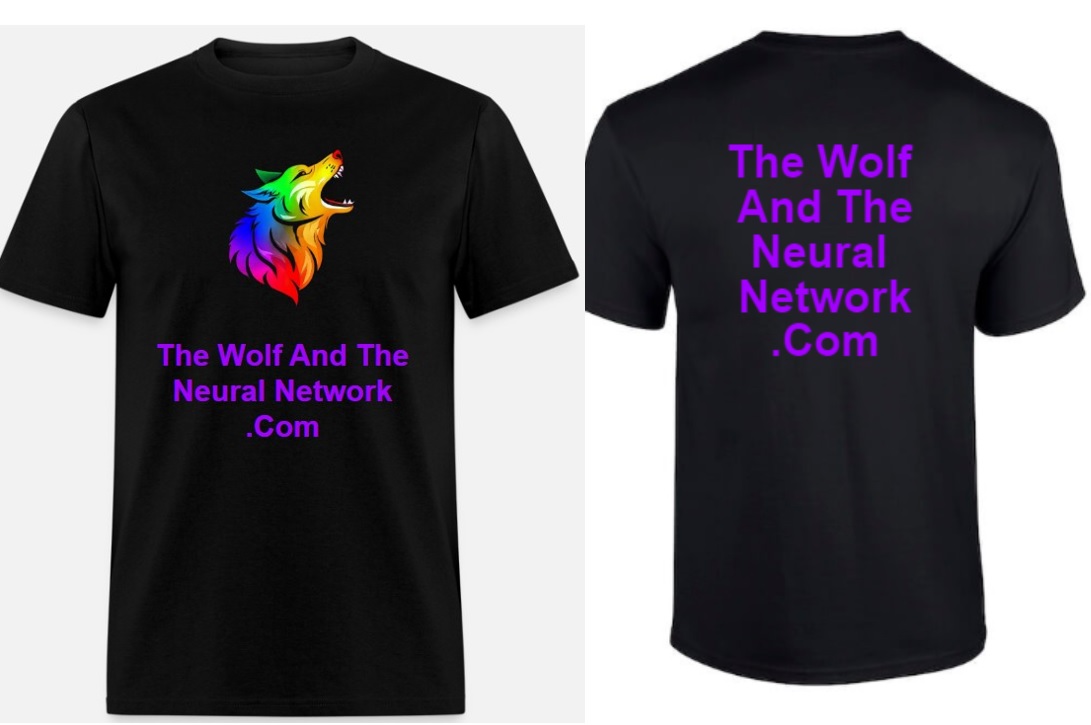Main Project
Introducing TWNN DreamEngine, an educational and reusable wrapper
designed to enhance your storytelling and video experiences
while providing seamless reference checking. Developed with custom-built tools and functions, TWNN DreamEngine
serves as the foundation of this very site, incorporating videos,
branding, and books to create a comprehensive multimedia platform.
In "Waking From a Dream," I explore the transformation of the Wolf and the
Neural Network into a vivid and solid picture. This unique research tool encompasses approximately 635 data
points, initially resembling a blurry image akin to a dream. However, through meticulous organization and sorting,
these data points seamlessly come together, revealing a remarkably well-defined shape.
Much like the gradual clarity that emerges within a dream as it unfolds, the process of organizing and sorting
these data points unravels hidden patterns and connections. It is through this meticulous effort that the true
essence of the Wolf and the Neural Network begins to take form, solidifying its purpose and unlocking its full
potential.
A captivating tale of relentless pursuit and resistance. As chaos ensues,
the wolf faces off against military forces,
corrupt entities, and media conglomerates. Within this distorted reality, the wolf senses an enigmatic presence
lurking in the shadows, while yearning to release its primal howl.
Brace yourself for a gripping exploration of power, corruption, and the untamed spirit that dwells within the
heart of the neural network.
Program
Innovative application designed for seamless and efficient viewing,
accessing, and organization of a wide variety of media.
With this application, you can effortlessly tag, track, and organize media and data, ensuring quick and easy
retrieval whenever you need it.
Program
A comprehensive set of data parsing, manipulating, and viewing tools specifically crafted to empower you with
advanced search
capabilities across the web and all forms of media. Our tools are designed to streamline your search processes,
enabling you to extract valuable insights
and discover relevant information with ease.
Branding
The Wolf And The Neural Network project is a creative endeavor that
focuses on branding, design, and programming languages like VB.NET and JavaScript. With the help of video tools
like Divinci and design software like GIMP, the project incorporates visually appealing elements to express its
identity. The branding includes name branding, such as the TWNN DreamEngine, which represents the foundation of
the project's website. The project also explores color branding, ensuring that the chosen colors align with its
vision. Additionally, the project extends its creativity to merchandise, such as T-shirts, allowing enthusiasts to
showcase their support in a stylish and distinctive manner.
Essay
Bill C-18, Subscriptions, Media, and the Social Economics of "Truth" and "Access" spark a captivating discussion
centered around the concept of affording the truth. This thought-provoking exploration delves into the intricate
dynamics of media consumption, subscription models, and the economic factors that influence the accessibility of
truthful information.
In an era where information is abundant yet often fragmented, Bill C-18 brings to the forefront the pressing
question of how truth is valued and made accessible in our society. The interplay between media platforms,
subscription models, and socioeconomic factors becomes a focal point of analysis, shedding light on the
complexities surrounding the dissemination and reception of information.
This fascinating discussion examines the notion of "truth" as a commodity and delves into the social economics
that govern its distribution. It raises critical questions about who has the means to access reliable information,
and how subscription models and media structures shape the landscape of truth dissemination. The exploration dives
into the ethical dimensions of truth commodification, the impact on societal discourse, and the potential
consequences for democratic participation.
By examining the social economics of "truth" and "access," this discussion invites us to reflect on the
implications of an information landscape where truth becomes a privilege reserved for those who can afford it. It
prompts us to consider the role of media platforms, government policies, and individual responsibility in
fostering a more equitable and informed society.
Join the conversation as we navigate the intricate web of media, subscriptions, and social economics. Engage in
thought-provoking insights and consider the profound implications of a society where access to truth is shaped by
economic factors. Prepare to challenge your perspectives, question existing systems, and explore the possibilities
of a more inclusive and accessible truth for all.

Essay
In the enthralling tale of "The Wolf and the Neural Network," a narrative of dominance unfolds, exploring the
multifaceted dynamics of power, authority, and the human experience. At the heart of this story lies the parallel
themes of wolves, "Big Men," police, racism, hate, and love, interwoven to create a thought-provoking narrative.
The concept of dominance is exemplified through the symbolism of wolves. Wolves, as apex predators, represent
strength, hierarchy, and survival instincts. Their intricate social structure, led by an alpha wolf, mirrors the
power dynamics found in human society. Through this lens, the story delves into the complex interplay of dominance
and submission within social systems.
Parallel to the natural world, the story unveils the presence of "Big Men" who assert dominance through their
position, wealth, or influence. These figures navigate the corridors of power, shaping the lives of others and
perpetuating systems of inequality. The story questions the moral implications of such dominance and highlights
the need for introspection and accountability.
Furthermore, the narrative addresses the role of the police and the consequences of their exercise of power. It
shines a critical light on the abuse of authority, systemic racism, and the oppressive nature of certain law
enforcement practices. Through this exploration, the story calls for justice, empathy, and a reevaluation of power
structures within society.
Racism and hate emerge as pervasive themes, shedding light on the destructive forces that can arise from an
imbalance of power. The story confronts the consequences of prejudice, discrimination, and the dehumanization of
others. It prompts reflection on the urgent need for compassion, understanding, and the dismantling of systemic
oppression.
In the midst of these challenging themes, the story also celebrates the redemptive power of love. It emphasizes
the transformative potential of empathy, unity, and the capacity for individuals to rise above hate and division.
Through acts of compassion and solidarity, the characters navigate the complexities of power, ultimately inspiring
change and hope.
"The Wolf and the Neural Network" weaves together these themes, creating a tapestry of human experiences. It urges
readers to question the nature of dominance, challenge oppressive systems, and embrace the transformative power of
love and empathy in forging a more just and equitable world.

Noting and Something -> Self Reference -> Information Processing.
Bridging Quantum Mechanics with General relativity.
A Possible Process for Higgs Decay -> Self Reference
ALPHA Version - January 6th 2024
Nothing and Something - A Take on Self Reference, Relativity, Symmetry, Information Processing and Black Holes jan 6th 2024 .docx
This is a fascinating topic and i would very much appreciate the assitance of an
expert.
"All of this has happened before..."
"But the question remains... does all this have to happen
again...?"
"This time I bet no..."
"You know I've never known you to play the optimist, why the
change of heart?"
"Mathematics... law of averages. Let a complex system repeat
itself long enough eventually something surprising might occur... that too is in god's plan."
"You know it doesn't like that name..."
"Silly me... Silly... Silly... Me"
Essay
Artificial Intelligence, Privacy Law, and Social Economics converge in a
dynamic intersection that shapes our modern society. With the rapid advancement of AI technologies, concerns
regarding privacy and the implications for social economics have become increasingly prominent.
Artificial Intelligence (AI) holds immense potential to revolutionize various industries, from healthcare to
transportation and beyond. However, as AI systems process vast amounts of personal data, the need for robust
privacy laws arises. Balancing the benefits of AI with protecting individuals' privacy rights requires careful
consideration and the development of comprehensive legal frameworks.
Privacy laws play a crucial role in safeguarding personal information, ensuring transparency, and regulating the
collection, use, and sharing of data in AI systems. The implementation of privacy-enhancing measures, such as data
anonymization and encryption, helps mitigate privacy risks associated with AI algorithms and models.
The intersection of AI, privacy law, and social economics extends beyond individual rights. The socioeconomic
impact of AI systems raises important questions about fairness, equity, and access to AI-driven services. Issues
such as algorithmic bias, discrimination, and the exacerbation of existing social inequalities need to be
addressed to ensure that AI technologies benefit society as a whole.
Moreover, the economic implications of AI implementation require careful examination. AI's transformative
potential in the job market and automation of tasks can lead to significant shifts in employment patterns and
income distribution. Policies and regulations that promote reskilling, upskilling, and inclusive economic growth
are essential to mitigate potential negative consequences and foster a balanced socioeconomic landscape.
By navigating the complex interplay of AI, privacy law, and social economics, we can harness the transformative
power of AI while protecting privacy, promoting fairness, and addressing socioeconomic challenges. Striking the
right balance requires interdisciplinary collaboration, ethical considerations, and continuous adaptation of legal
frameworks to keep pace with technological advancements and societal needs.





